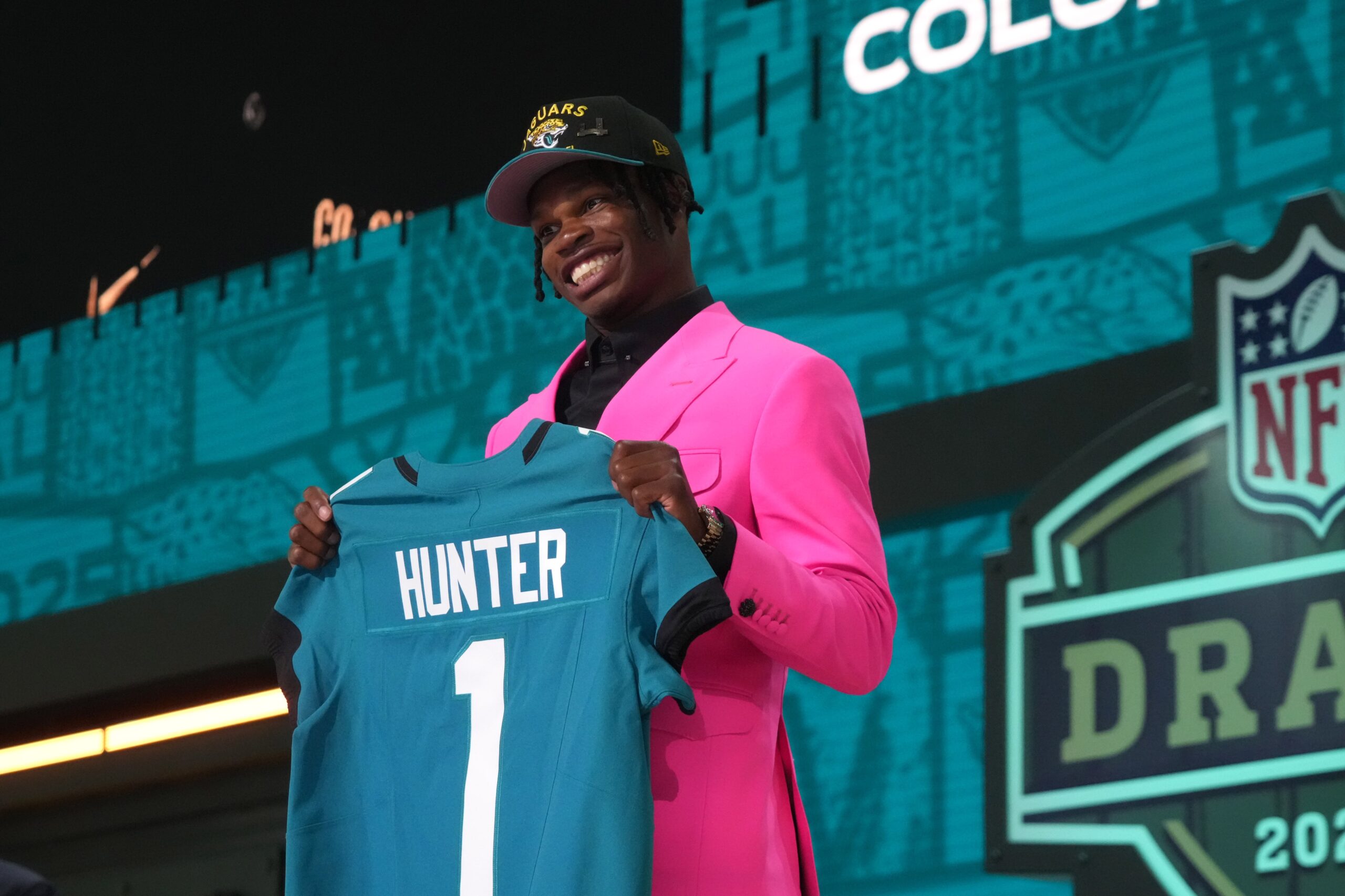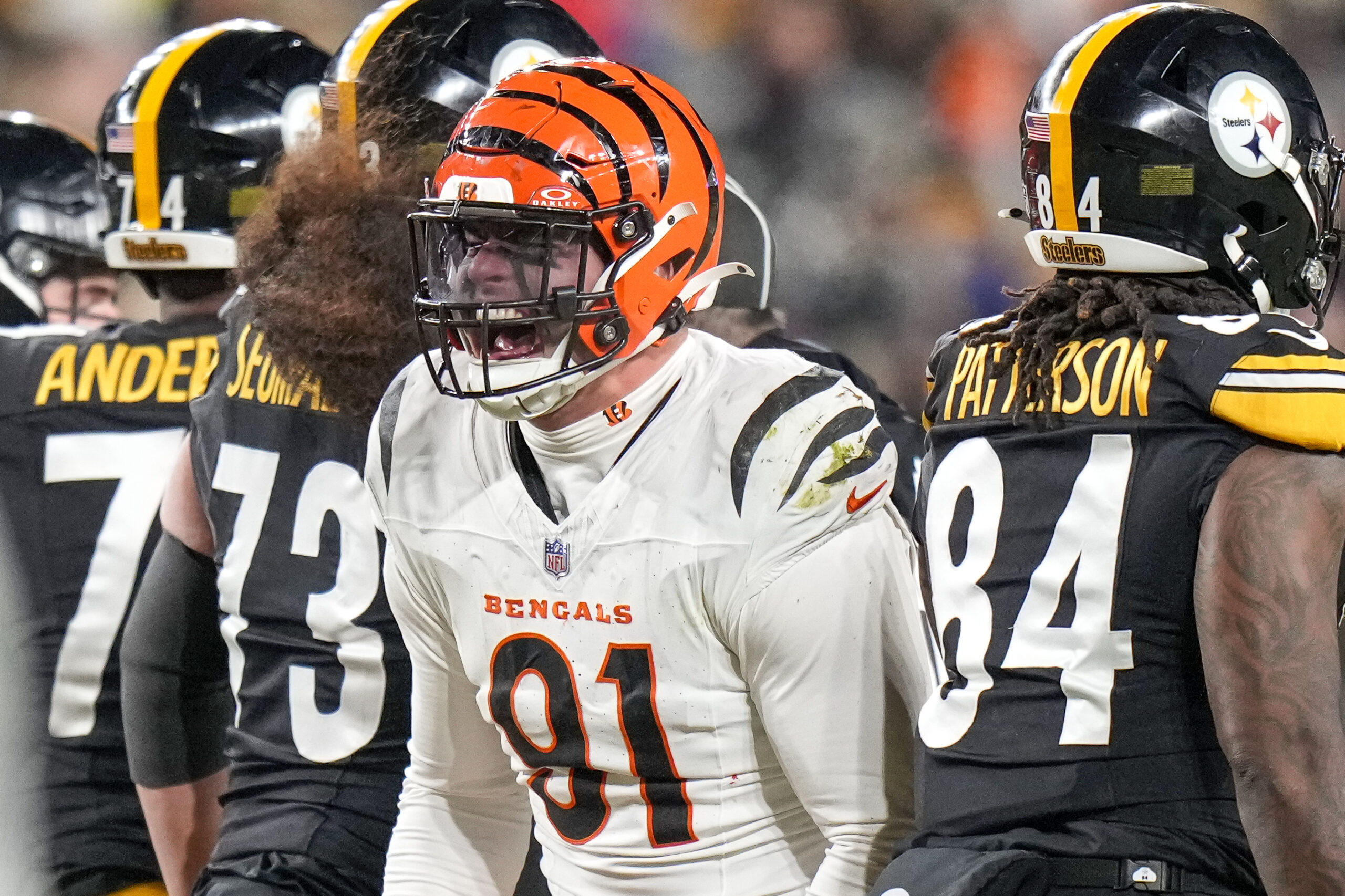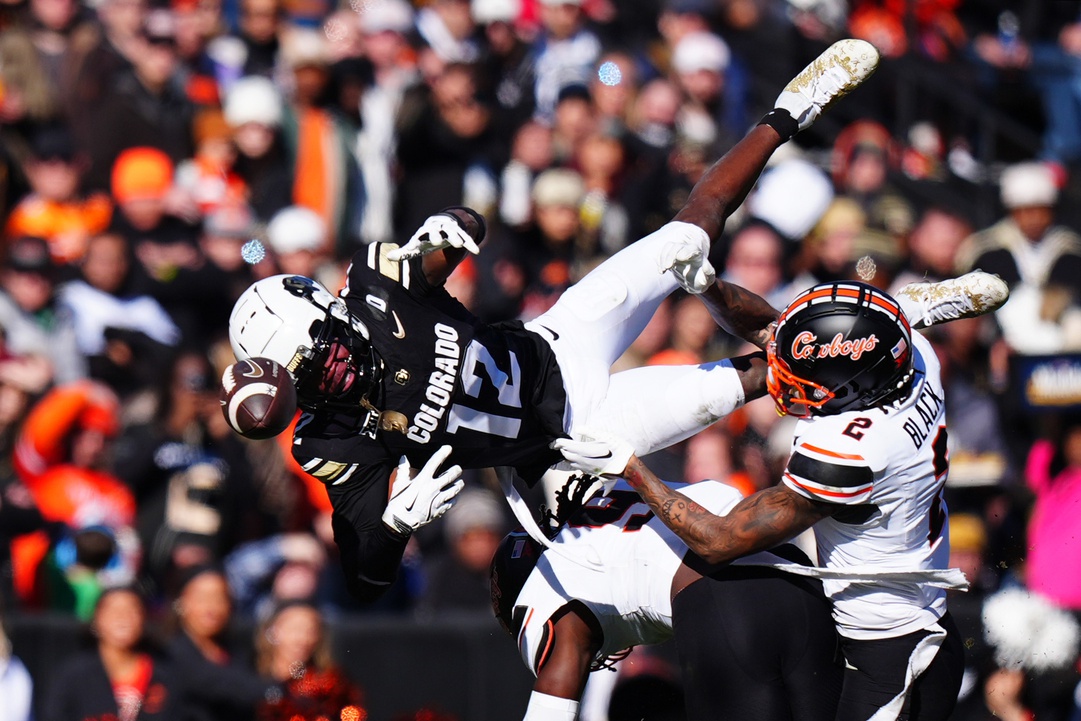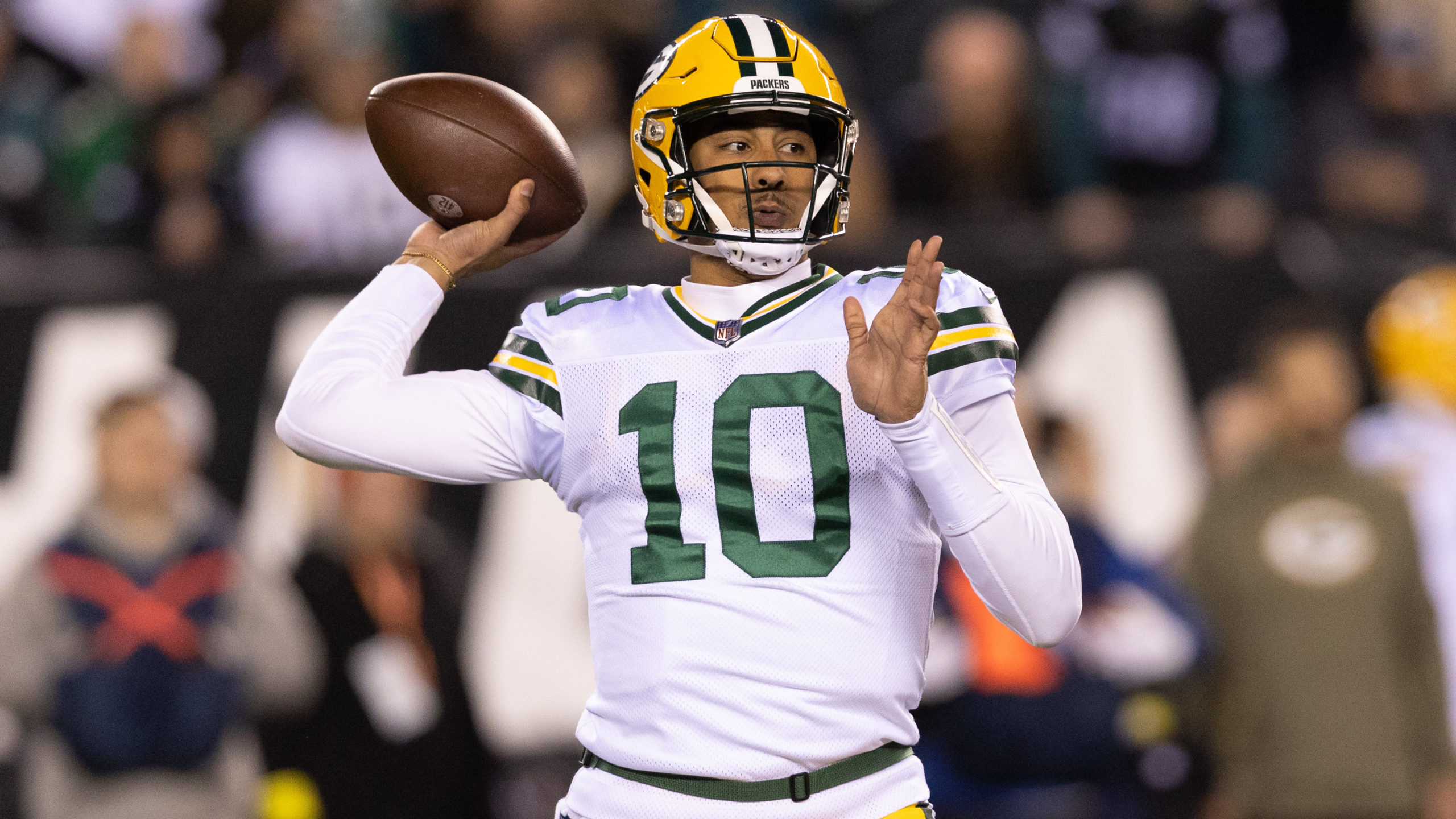NFL Analysis
4/2/24
9 min read
What Does Accuracy Tell Us About the 2024 Quarterback Draft Class?

“A naturally accurate guy could walk in here right now and throw the football anywhere they want, and it just makes sense to them when they pick up the football,” Minnesota Vikings coach Kevin O’Connell said at the NFL Combine, discussing the foundational traits for a quarterback.
“Maybe that’s where it’s a little different trying to figure out what the ceiling is from that standpoint,” O’Connell stated, getting to the crux of the current quarterback scouting and development conundrum.
Accuracy remains a core tenant of quarterback play, but it can be placed on a sliding scale of importance for the modern quarterback.
Adam Harstad of Footballguys coined the idea of a three-legged stool for quarterback production, including yards per attempt, interception rate and sack rate. The best quarterbacks can find success at all three, but the majority of quarterbacks have to make tradeoffs from one area to serve another.
We’re now in a similar spot for quarterback traits, with the stool's three legs being accuracy, arm strength and creativity.
Some of the best quarterbacks can balance all three, but even then, all sliders aren’t always pushed to 100. Patrick Mahomes has the arm and creativity but isn’t always the most accurate quarterback on a play-to-play basis.
Mahomes can make any throw, yet his superhuman arm and creativity allow him more chances to make the highlight plays. Some quarterbacks can only give themselves one chance per game to make the throws Mahomes routinely gives himself a shot at making. Josh Allen is on a similar spectrum.
Then, there are the quarterbacks who need accuracy because the other traits aren’t always there. Think of Joe Burrow and Tua Tagovailoa, who, in different ways, use top-tier accuracy to compensate for arm strength that doesn’t reach the Mahomes/Allen/Justin Herbert tier.
As O’Connell said, finding the ceiling on that type of prospect can be difficult. Accuracy without some of those other high-level traits can be futile.
2024 Class Isn't Perfect
That brings us to the 2024 quarterback draft class. This is not as clean a quarterback class as some hype suggests, though keeping the sliding scale in mind is important.
For this exercise, we’ll look at completion percentage and on-target rate, as charted by Sports Info Solutions, for each depth of the field.
SIS defines on-target percentage as “a pass that hits the receiver in stride, regardless of whether the pass is completed.” It’s not a perfect one-for-one stand-in for accuracy, but it paints a picture of ball placement we can use to set up a prospect’s profile.
Here’s a look at the 2024 class with their depth rates, completion rates and on-target rates compared to each other.

The first thing to note is how different the college and NFL games are from a depth standpoint. Only the quarterbacks listed above threw passes between 1-10 air yards on more than 40 percent of their attempts.
Meanwhile, NFL quarterbacks live in this world. Among 32 qualified quarterbacks in 2023, only three were below 40 percent. The average for NFL quarterbacks last season was 47.7 percent.
What’s surprising is that no quarterback stands out across all areas of the field. By on-target rate, there are not many standouts compared to past prospects.
By looking at a 114-quarterback sample going back to 2017, we can see where the players in this class rank by percentile in on-target and completion rates to each area of the field:
There’s a lot to take in here, so take it a little bit at a time. Looking at this table, the major takeaway for most prospects is that the completion percentages stack up better than the on-target rates for this entire quarterback sample.
Williams vs. Maye
It’s easy to draw attention to some of the percentiles for Caleb Williams and Drake Maye. Williams is the clear favorite to go first overall, and Maye is a 1B option for many.
Neither had a great 2023 season, but there was still production despite less-than-ideal circumstances. Williams was still 11th in QBR, and Maye ranked 14th.
Williams' on-target rate in the short and deep areas of the field is near the 50th percentile, while his intermediate passing is in just the fifth percentile. Still, the completion rates hold up well above the 50th percentile in the three areas, with his deep passing in the 93rd percentile by completion percentage.
Last season, Williams often had to make things happen when the structure failed, which made some aspects of his game look worse or less controlled than reality. It’s easy to see where his game translates and how an offense can be built around his skill set.
Maye’s numbers reflect a quarterback who took a step back during his final college season.
His intermediate on-target rate lands in just the third percentile of this 114-quarterback sample, which is alarming. If there is an area where some of Maye’s footwork concerns come into play, it’s on these throws in the offense's intended rhythm.
But this isn’t an area Maye has struggled with throughout his career. It was the exact opposite in 2022, when his on-target rate would have been in the 68th percentile of this sample while his completion percentage would have been in the 83rd percentile.
Maye threw 11 or more yards down the field on 39 percent of his passes in 2023, tied for the most in this draft class. North Carolina asked Maye to do a ton with much help from his supporting cast.
Still, Maye’s completion rates heavily outpaced his on-target rates, especially on deep throws. Completing passes above expectations has been a hallmark of Maye’s career.
SIS charts a stat called completion plus/minus, which tracks how well a quarterback completes passes over expectation based on route type, coverage, distance and whether the defense generated pressure.
Maye is the career leader among the quarterbacks in this class.
Maye’s degree of difficulty can overshadow some of his raw statistics, or even when you see him miss throws on film. He still has enough in the arm strength/creativity buckets to make up for some down-to-down inconsistency, especially if he gets time to develop in a real offense.
The Best of The Rest
Some consider Jayden Daniels the No. 2 quarterback in this class. The reigning Heisman winner has a big arm, and his deep passing is the highlight of his profile. Daniels had an 88th-percentile on-target rate on throws of 20 or more air yards and a 100th-percentile completion percentage.
But there are legitimate questions about his short and intermediate passing. Daniels is not a high-volume intermediate thrower and has avoided the intermediate middle of the field. If we’ve seen mobile quarterbacks have a fatal flaw in the NFL, it’s avoiding the area that is one of the most valuable to target.
Daniels has the potential to be the most creative passer in this class, but the majority of his sack avoidance turns into scrambles rather than throws on the run. Doing so while taking hits and not having spatial awareness like Lamar Jackson or Kyler Murray could make that scramble volume a dangerous habit in the NFL.
The one passer with some on-target juice is Bo Nix. Nix can flash accuracy but wasn’t asked to do much in Oregon’s offense. In 2023, just two-thirds of his passes went beyond the line of scrimmage, and most targeted the short area.
Just 25 percent of Nix’s throws traveled 11 or more yards past the line of scrimmage, the lowest rate in this class.
Nix has some high-level throws in his bag, but it could be asking a lot of him to open that up to a higher volume in an NFL offense. He doesn’t quite have the arm to get himself out of trouble. While he has some athleticism, his accuracy can fail when under pressure. His profile could be relying too heavily on hoping the accuracy on limited NFL-caliber throws translates as a pro.
Michael Penix is one of the most fascinating profiles, with on-target rates that fall in the sixth percentile for short and intermediate passes.
But almost every on-target pass was caught in the Washington offense, leaving Penix with 75th- and 64th-percentile completion percentages to those areas of the field, respectively. It’s tough to live in a world of inconsistent accuracy while hoping all the accurate throws will be caught.
There’s something slightly similar to J.J. McCarhy’s profile, but not quite to the same extreme. McCarthy topped out in the 32nd percentile for on-target rate to the intermediate level of the field but was no worse than the 73rd percentile in completion percentage to any area of the field.
McCarthy’s biggest knock is he wasn’t asked to do much in high-leverage situations. He had mostly ideal, controlled environments on early downs off play-action. At the same time, he threw beyond the line of scrimmage at a higher rate than any quarterback in this class, so a heavy dose of throws behind the line did not mask his production.
He has some of the creativity needed to make things happen, but McCarthy doesn’t have the plus arm to make that a get-out-of-jail-free card.
There’s something to like about each of the top prospects, but none come out completely clean. Accuracy remains a foundational piece of the modern quarterback, but it’s not a binary yes or no evaluation.
Sure, a baseline is needed. However, other traits can determine how important accuracy is to the overall picture. How this quarterback class develops those traits might be our biggest test case.








